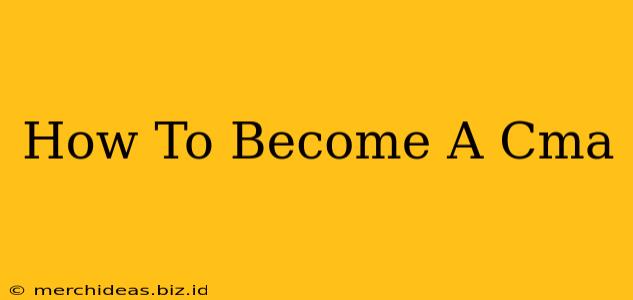Want to boost your career in management accounting and earn a globally recognized credential? Becoming a Certified Management Accountant (CMA) is a smart move. This guide breaks down the process, helping you navigate the path to CMA certification.
Understanding the CMA Certification
The CMA certification, offered by the Institute of Management Accountants (IMA), demonstrates advanced competency in management accounting and financial management. It's a highly respected credential that opens doors to leadership roles and higher earning potential. CMAs are in demand across various industries.
Why Choose the CMA Certification?
- Enhanced Earning Potential: CMAs typically command higher salaries than their non-certified counterparts.
- Career Advancement: The credential significantly improves career prospects and opens doors to senior management positions.
- Global Recognition: The CMA is internationally recognized, making it valuable wherever you choose to work.
- Advanced Skills: The rigorous exam tests your knowledge of financial planning, analysis, decision support, and more.
- Professional Development: The process encourages ongoing learning and professional growth within the field.
Steps to Becoming a CMA
The path to CMA certification involves several key stages:
1. Education Requirements
You need a bachelor's degree (or equivalent) from an accredited institution. While there's no specific major requirement, a strong background in accounting or finance is highly advantageous.
2. CMA Exam Preparation
The CMA exam is challenging and requires dedicated preparation. Effective study strategies are crucial. Consider:
- Review Courses: Reputable providers offer comprehensive courses covering all exam topics.
- Study Materials: Textbooks, practice exams, and online resources are essential tools.
- Time Management: Allocate sufficient time for studying – a consistent study schedule is key.
- Practice Exams: Regularly taking practice exams helps assess your progress and identify weak areas.
3. The CMA Exam
The CMA exam consists of two parts:
- Part 1: Financial Planning, Performance, and Analytics: Covers topics like financial statement analysis, budgeting, performance measurement, and cost management.
- Part 2: Financial Decision Making: Focuses on areas such as corporate finance, risk management, internal controls, and decision-making techniques.
Each part is a three-hour computer-based exam. Passing both parts is necessary to earn the certification.
4. Experience Requirement
After passing both parts of the exam, you need to fulfill the experience requirement. This typically involves two continuous years of professional experience in management accounting or a related field.
5. Membership in the IMA
Becoming a member of the Institute of Management Accountants (IMA) is not mandatory for CMA certification but highly recommended. Membership provides access to valuable resources, networking opportunities, and ongoing professional development.
Tips for Success
- Create a Study Plan: Develop a structured study plan that allocates sufficient time to each exam section.
- Join Study Groups: Collaborating with others can enhance understanding and motivation.
- Utilize IMA Resources: The IMA offers excellent resources to support your preparation.
- Stay Updated: Management accounting is a dynamic field. Stay current on industry trends and regulations.
- Maintain Professional Development: Continuing your education after earning the certification is important for career advancement.
FAQs About the CMA Exam
- How long does it take to become a CMA? The timeframe varies depending on individual preparation and exam attempts, but it typically takes 6-12 months.
- What is the cost of the CMA exam? Exam fees are set by the IMA and can vary.
- How many times can I retake the exam? There is no limit on the number of times you can retake each exam part.
Becoming a CMA requires dedication and effort, but the rewards are substantial. The certification significantly enhances career prospects, earning potential, and professional credibility. By following these steps and utilizing available resources, you can successfully achieve your goal of becoming a Certified Management Accountant.
